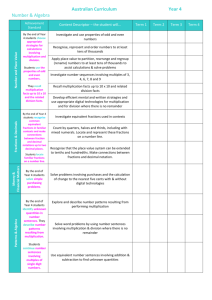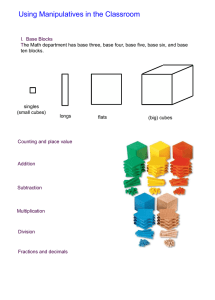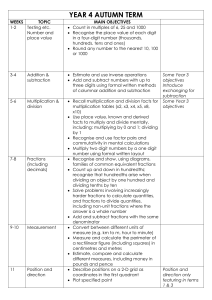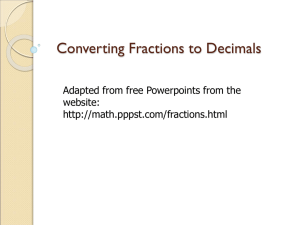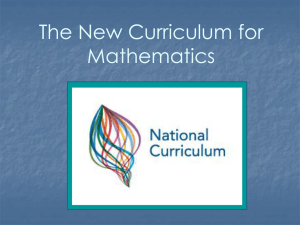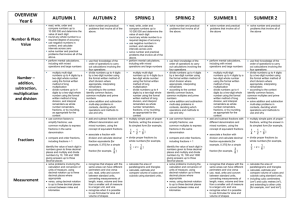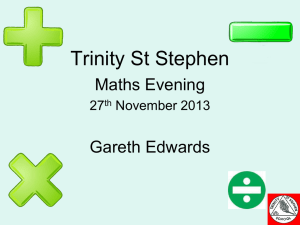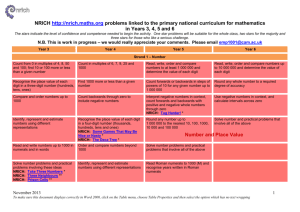Understanding Maths UKS2 - imaginative
advertisement
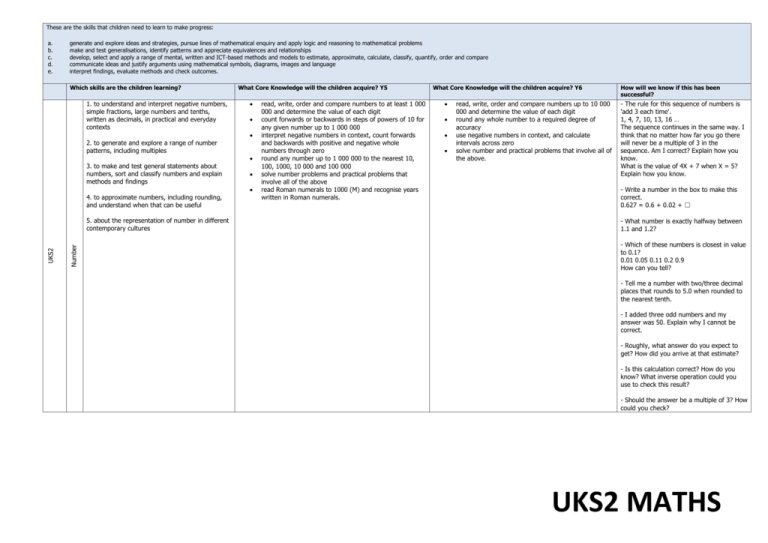
These are the skills that children need to learn to make progress: a. b. c. d. e. generate and explore ideas and strategies, pursue lines of mathematical enquiry and apply logic and reasoning to mathematical problems make and test generalisations, identify patterns and appreciate equivalences and relationships develop, select and apply a range of mental, written and ICT-based methods and models to estimate, approximate, calculate, classify, quantify, order and compare communicate ideas and justify arguments using mathematical symbols, diagrams, images and language interpret findings, evaluate methods and check outcomes. Which skills are the children learning? 1. to understand and interpret negative numbers, simple fractions, large numbers and tenths, written as decimals, in practical and everyday contexts 2. to generate and explore a range of number patterns, including multiples 3. to make and test general statements about numbers, sort and classify numbers and explain methods and findings 4. to approximate numbers, including rounding, and understand when that can be useful Number UKS2 5. about the representation of number in different contemporary cultures What Core Knowledge will the children acquire? Y5 read, write, order and compare numbers to at least 1 000 000 and determine the value of each digit count forwards or backwards in steps of powers of 10 for any given number up to 1 000 000 interpret negative numbers in context, count forwards and backwards with positive and negative whole numbers through zero round any number up to 1 000 000 to the nearest 10, 100, 1000, 10 000 and 100 000 solve number problems and practical problems that involve all of the above read Roman numerals to 1000 (M) and recognise years written in Roman numerals. What Core Knowledge will the children acquire? Y6 read, write, order and compare numbers up to 10 000 000 and determine the value of each digit round any whole number to a required degree of accuracy use negative numbers in context, and calculate intervals across zero solve number and practical problems that involve all of the above. How will we know if this has been successful? - The rule for this sequence of numbers is 'add 3 each time'. 1, 4, 7, 10, 13, 16 … The sequence continues in the same way. I think that no matter how far you go there will never be a multiple of 3 in the sequence. Am I correct? Explain how you know. What is the value of 4X + 7 when X = 5? Explain how you know. - Write a number in the box to make this correct. 0.627 = 0.6 + 0.02 + ☐ - What number is exactly halfway between 1.1 and 1.2? - Which of these numbers is closest in value to 0.1? 0.01 0.05 0.11 0.2 0.9 How can you tell? - Tell me a number with two/three decimal places that rounds to 5.0 when rounded to the nearest tenth. - I added three odd numbers and my answer was 50. Explain why I cannot be correct. - Roughly, what answer do you expect to get? How did you arrive at that estimate? - Is this calculation correct? How do you know? What inverse operation could you use to check this result? - Should the answer be a multiple of 3? How could you check? UKS2 MATHS 6. to use proportional reasoning to compare numbers and quantities and solve problems 7. to extend their knowledge of multiplication facts to 10×10 and use them to solve multiplication and division problems 8. to understand and use different models of division, including interpreting the outcome of a division calculation, in relation to the context, where the answer is not a whole number 9. to recognise and use the relationship between fractions and division and represent division as number sentences 10. to recognise and use the relationships between addition, subtraction, multiplication and division 11. to develop a range of strategies including mental and written ones, for calculating and checking, including using a calculator or computer efficiently Calculation 12. to solve multi-step problems involving more than one operation 13. to solve problems related to borrowing, spending and saving 14. to understand and convert between different currencies 15. how to manage money and prepare budgets for events, including using spreadsheets add and subtract whole numbers with more than 4 digits, including using formal written methods (columnar addition and subtraction) add and subtract numbers mentally with increasingly large numbers use rounding to check answers to calculations and determine, in the context of a problem, levels of accuracy solve addition and subtraction multi-step problems in contexts, deciding which operations and methods to use and why. identify multiples and factors, including finding all factor pairs of a number, and common factors of two numbers. solve problems involving multiplication and division where larger numbers are used by decomposing them into their factors know and use the vocabulary of prime numbers, prime factors and composite (non-prime) numbers establish whether a number up to 100 is prime and recall prime numbers up to 19 multiply numbers up to 4 digits by a one- or two-digit number using a formal written method, including long multiplication for two-digit numbers multiply and divide numbers mentally drawing upon known facts divide numbers up to 4 digits by a one-digit number using the formal written method of short division and interpret remainders appropriately for the context multiply and divide whole numbers and those involving decimals by 10, 100 and 1000 recognise and use square numbers and cube numbers, and the notation for squared (2) and cubed (3) solve problems involving addition, subtraction, multiplication and division and a combination of these, including understanding the meaning of the equals sign solve problems involving multiplication and division, including scaling by simple fractions and problems involving simple rates. compare and order fractions whose denominators are all multiples of the same number identify, name and write equivalent fractions of a given fraction, represented visually, including tenths and hundredths recognise mixed numbers and improper fractions and convert from one form to the other and write mathematical statements > 1 as a mixed number (e.g. 2/5 + 4/5 = 6/5 = 11/5) add and subtract fractions with the same denominator and multiples of the same number multiply proper fractions and mixed numbers by whole numbers, supported by materials and diagrams read and write decimal numbers as fractions (e.g. 0.71 = 71/100) recognise and use thousandths and relate them to tenths, hundredths and decimal equivalents round decimals with two decimal places to the nearest whole number and to one decimal place read, write, order and compare numbers with up to three decimal places solve problems involving number up to three decimal places recognise the per cent symbol (%) and understand that per cent relates to “number of parts per hundred”, and write percentages as a fraction with denominator multiply multi-digit numbers up to 4 digits by a twodigit whole number using the formal written method of long multiplication divide numbers up to 4 digits by a two-digit whole number using the formal written method of long division, and interpret remainders as whole number remainders, fractions, or by rounding, as appropriate for the context perform mental calculations, including with mixed operations and large numbers. identify common factors, common multiples and prime numbers use their knowledge of the order of operations to carry out calculations involving the four operations solve addition and subtraction multi-step problems in contexts, deciding which operations and methods to use and why solve problems involving addition, subtraction, multiplication and division use estimation to check answers to calculations and determine, in the context of a problem, levels of accuracy. multiply multi-digit numbers up to 4 digits by a twodigit whole number using the formal written method of long multiplication divide numbers up to 4 digits by a two-digit whole number using the formal written method of long division, and interpret remainders as whole number remainders, fractions, or by rounding, as appropriate for the context use common factors to simplify fractions; use common multiples to express fractions in the same denomination compare and order fractions, including fractions >1 add and subtract fractions with different denominators and mixed numbers, using the concept of equivalent fractions multiply simple pairs of proper fractions, writing the answer in its simplest form (e.g. 1/4 × 1/2 = 1/8) divide proper fractions by whole numbers (e.g. 1/3 ÷ 2 = 1/6 ) associate a fraction with division and calculate decimal fraction equivalents (e.g. 0.375) for a simple fraction (e.g. 3/8) identify the value of each digit to three decimal places and multiply and divide numbers by 10, 100 and 1000 where the answers are up to three decimal places multiply one-digit numbers with up to two decimal places by whole numbers use written division methods in cases where the answer has up to two decimal places solve problems which require answers to be rounded to specified degrees of accuracy recall and use equivalences between simple fractions, decimals and percentages, including in different contexts. - Look at these calculations with two-digit decimals. Tell me how you could work them out in your head. What other method could you use? - Two numbers have a difference of 1.583 and one of the numbers is 4.728. What is the other? Is this the only answer? - Look at these calculations. Which of them is incorrect? Why? 12.4 × 6.6 = 71.23 48.6 ÷ 3 = 16.2 - Work out 32.75 − 1.837. Explain each step to me. - What tips would you give to someone to help with long multiplication of HTU × TU? - What are important things to remember when you solve word problems? - What clues do you look for in the wording of questions? What words mean you need to add, subtract, multiply or divide? - Make up two different word problems for each of these calculations. Try to use a variety of words. (17 + 5) × 6 12.5 ÷ 5 − 0.25 - Make up a question involving addition that has the answer 1.35. Now try subtraction. What about multiplication? Division? - How can you use factors to multiply 17 by 12? - Which of these subtractions can you do without writing anything down? Why is it possible to solve this one mentally? What clues did you look for? What is the answer to the one that can be solved mentally? - Printing charges for a book are 3p per page and 75p for the cover. I paid £4.35 to get this book printed. Work out on your calculator how many pages there are in the book. Write down the calculations that you did. - Seeds are £1.45 for a packet. I have £10 to spend on seeds. What is the greatest number of packets I can buy? Show me how you used your calculator to find the answer. UKS2 MATHS Measures 16. to recognise when area, volume and mass are conserved 17. to convert between units within the metric system 18. to use an angle measurer to measure angles in degrees 19. to solve problems involving time and time intervals, including time represented by the 24hour clock 20. to use decimal calculations to solve problems with measures convert between different units of metric measure (e.g. kilometre and metre; centimetre and metre; centimetre and millimetre; gram and kilogram; litre and millilitre) understand and use equivalences between metric units and common imperial units such as inches, pounds and pints measure and calculate the perimeter of composite rectilinear shapes in centimetres and metres calculate and compare the area of squares and rectangles including using standard units, square centimetres (cm2) and square metres (m2) and estimate the area of irregular shapes estimate volume (e.g. using 1 cm3 blocks to build cubes and cuboids) and capacity (e.g. using water) solve problems involving converting between units of time use all four operations to solve problems involving measure (e.g. length, mass, volume, money) using decimal notation including scaling. RATIO AND PROPORTION solve problems involving the relative sizes of two quantities where missing values can be found by using integer multiplication and division facts solve problems involving the calculation of percentages (e.g. of measures) such as 15% of 360 and the use of percentages for comparison solve problems involving similar shapes where the scale factor is known or can be found solve problems involving unequal sharing and grouping using knowledge of fractions and multiples. ALGEBRA express missing number problems algebraically use simple formulae expressed in words generate and describe linear number sequences find pairs of numbers that satisfy number sentences involving two unknowns enumerate all possibilities of combinations of two variables. solve problems involving the calculation and conversion of units of measure, using decimal notation up to three decimal places where appropriate use, read, write and convert between standard units, converting measurements of length, mass, volume and time from a smaller unit of measure to a larger unit, and vice versa, using decimal notation to up to three decimal places convert between miles and kilometres recognise that shapes with the same areas can have different perimeters and vice versa recognise when it is possible to use formulae for area and volume of shapes calculate the area of parallelograms and triangles calculate, estimate and compare volume of cubes and cuboids using standard units, including centimetre cubed (cm3) and cubic metres (m3), and extending to other units such as mm3 and km3. - Six cakes cost one pound eighty. How much do ten cakes cost? - Here is part of a number line. Write the two missing numbers in the boxes. - In a country dance there are 3 boys and 2 girls in every line. 42 boys take part in the dance. How many girls take part? For a different dance there are 45 children. How many boys are there? - How would you change an amount of money from pounds sterling to euros? Record it for me, using symbols. - Solve this problem: A bottle holds 1 litre of lemonade. Rachel fills 5 glasses with lemonade. She puts 150 millilitres in each glass. How much lemonade is left in the bottle? - Now write a question of your own that would involve converting units. - This graph converts miles to kilometres. Use it to estimate a distance of 95 miles in kilometres. - Give me an example of when: you would need an accurate measure of length; you would be able to use a less-accurate recording. - What is the most accurate measure of length you can make with the equipment in our classroom? Explain why. UKS2 MATHS 21. to use and make maps, scale models and diagrams for a purpose 22. to understand area as the space enclosed by a perimeter on a plane, and find areas of rectangles and related shapes Shape/Geometry/Position 23. to solve practical problems involving 3D objects 24. to visualise geometric objects38 and to recognise and make 2D representations of 3D shapes 25. to create and refine sequences of instructions, using ICT to construct and explore geometric patterns and problems 26. to explore aspects of geometry to find out about its origins, and its use in different cultures, religions, art and architecture identify 3-D shapes, including cubes and other cuboids, from 2-D representations know angles are measured in degrees: estimate and compare acute, obtuse and reflex angles draw given angles, and measure them in degrees (o) identify: angles at a point and one whole turn (total 360o) angles at a point on a straight line and ½ a turn (total 180o) other multiples of 90o use the properties of rectangles to deduce related facts and find missing lengths and angles distinguish between regular and irregular polygons based on reasoning about equal sides and angles. identify, describe and represent the position of a shape following a reflection or translation, using the appropriate language, and know that the shape has not changed. draw 2-D shapes using given dimensions and angles recognise, describe and build simple 3-D shapes, including making nets compare and classify geometric shapes based on their properties and sizes and find unknown angles in any triangles, quadrilaterals, and regular polygons illustrate and name parts of circles, including radius, diameter and circumference and know that the diameter is twice the radius recognise angles where they meet at a point, are on a straight line, or are vertically opposite, and find missing angles. describe positions on the full coordinate grid (all four quadrants) draw and translate simple shapes on the coordinate plane, and reflect them in the axes. - Imagine a triangular prism. How many faces does it have? Are any of the faces parallel to each other? - How many pairs of parallel edges has a square-based pyramid? How many perpendicular edges? - Look at these 3-D shapes (e.g. a cuboid, tetrahedron, square-based pyramid and octahedron). Show me a face that is parallel to this one. Which face is perpendicular to this one? - What can you tell me about the faces of a cuboid? Why are so many packing boxes made in the shape of a cuboid? - Which of these shapes is incorrectly placed on this Carroll diagram? Change the criteria so the shapes are correctly sorted according to their properties. - Use your ruler and protractor. Draw the net of a regular tetrahedron with edges of 6 cm. - Use compasses to draw a circle. Use a ruler and protractor to draw a regular pentagon with its vertices on the circumference of the circle. - Tell me an example of a circular object that would have a radius of about 5 cm. What about 50 cm? 500 cm? UKS2 MATHS 27. how statistics are used in society today 28. to use different kinds of averages and range to summarise and compare data sets solve comparison, sum and difference problems using information presented in a line graph complete, read and interpret information in tables, including timetables. interpret and construct pie charts and line graphs and use these to solve problems calculate and interpret the mean as an average. Data/Statistics 29. to use data to assess likelihood and risk and develop an understanding of probability through computer simulations, games and consideration of outcomes of everyday situations 30. to discuss, sort and order events according to their likelihood of occurring 31. to answer questions or test hypotheses by using ICT to collect, store, analyse and present data 32. to use ICT to represent data on a scattergraph, and proportional data in a pie chart in order to explore possible relationships and interpret the findings - Give children some statements to consider: - It is hotter now than it was 30 years ago. The local high street should be made pedestrian only. The tombola makes the most money at the summer fete. - Turn these statements into questions that you could investigate. Suggest a plan for finding out whether the statements are true or false. - [Show graphs with the title, labels on the axes and intervals hidden.] What could this graph represent? If so, what would these labels be? How would this scale be numbered? State three conclusions you can draw from the information in this graph. - Here is a bar chart showing rainfall. Kim says: 'The dotted line on the chart shows the mean rainfall for the four months.' Use the chart to explain why Kim cannot be correct. - Use the information in the graph below and a calculator to work out how many pounds (£) you would get for 24.80 euros. How will the children be enabled to do this? ‘Breadth of Learning’ During the year, pupils should be taught the knowledge, skills and understanding through: a. practical activity, exploration and discussion b. using mathematical ideas in practical activities, then recording these using objects, pictures, diagrams, words, numbers and symbols c. using mental images of numbers and their relationships to support the development of mental calculation strategies d. estimating, drawing and measuring in a range of practical contexts e. drawing inferences from data in practical activities f. exploring and using a variety of resources and materials, including ICT g. activities that encourage them to make connections between number work and other aspects of their work in mathematics. UKS2 MATHS
